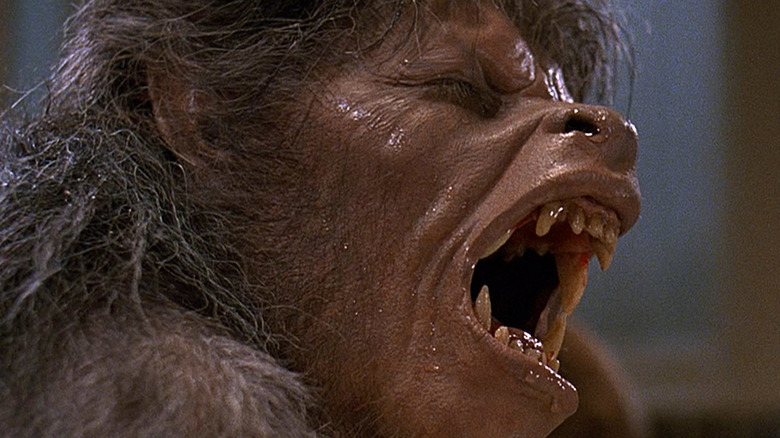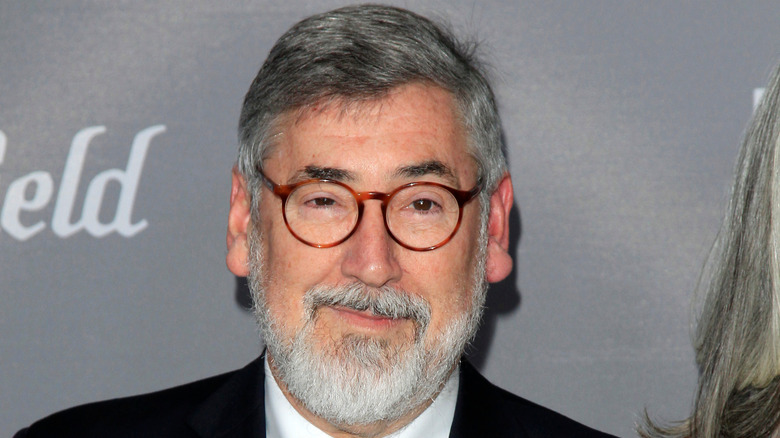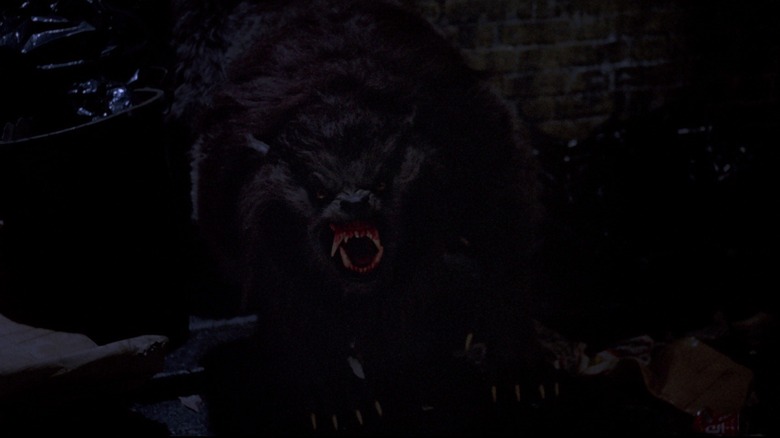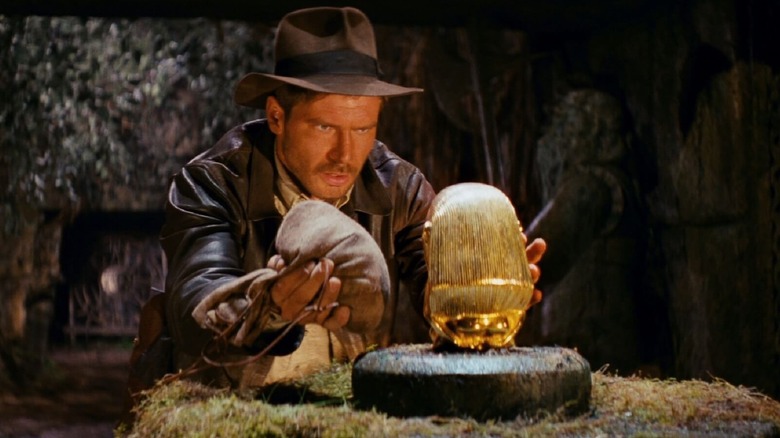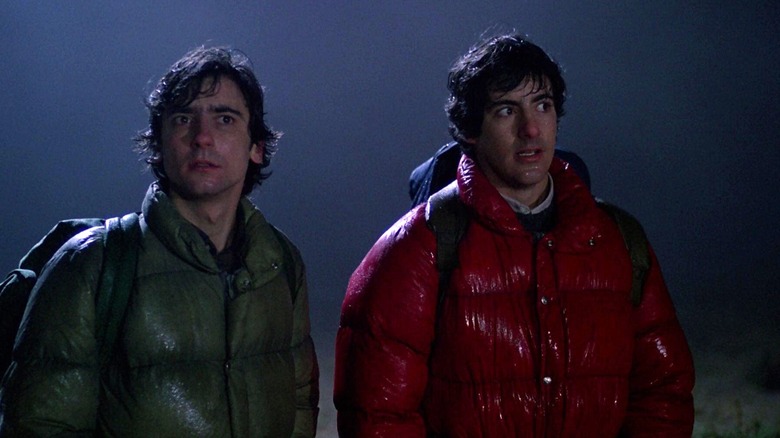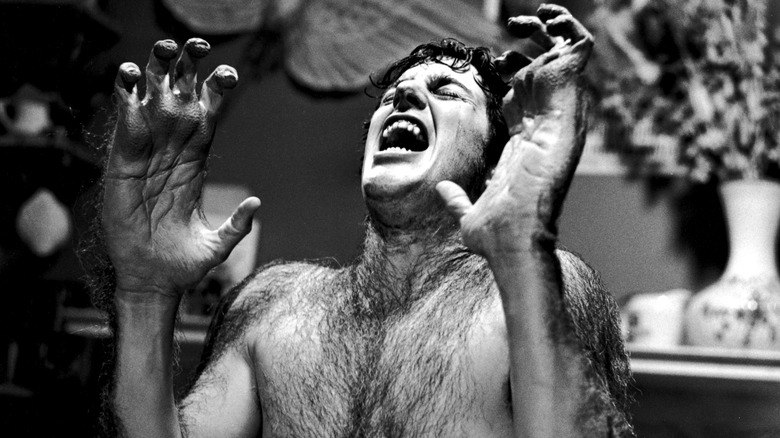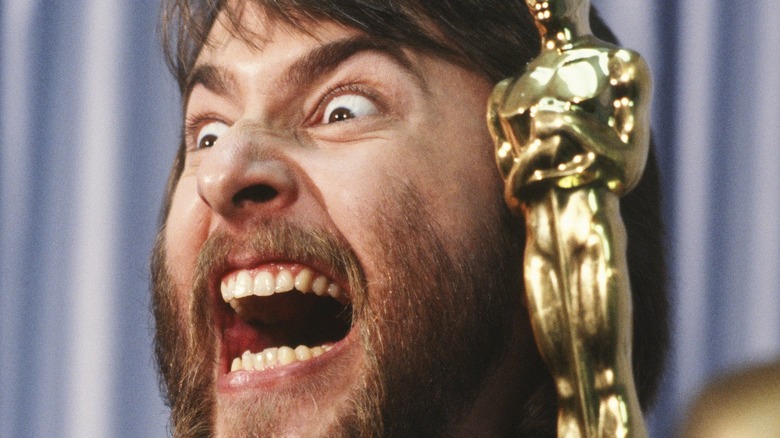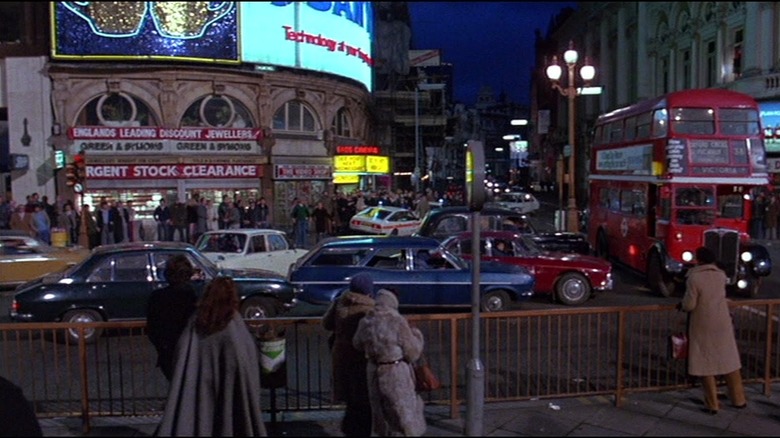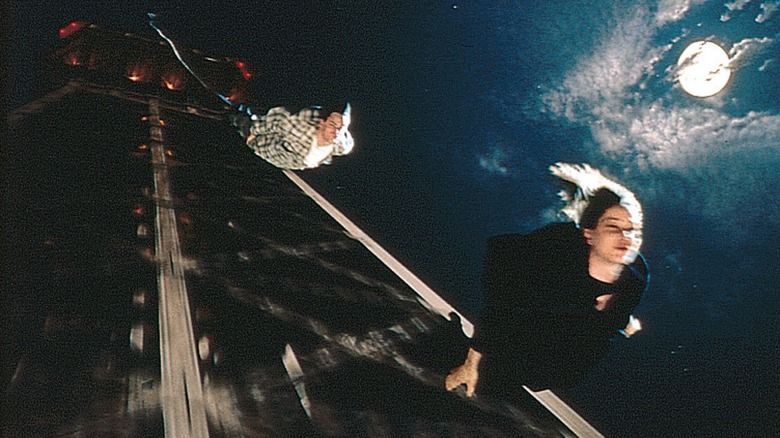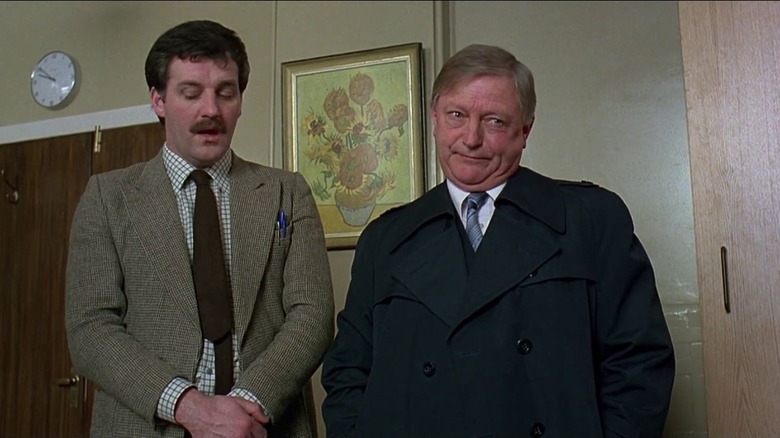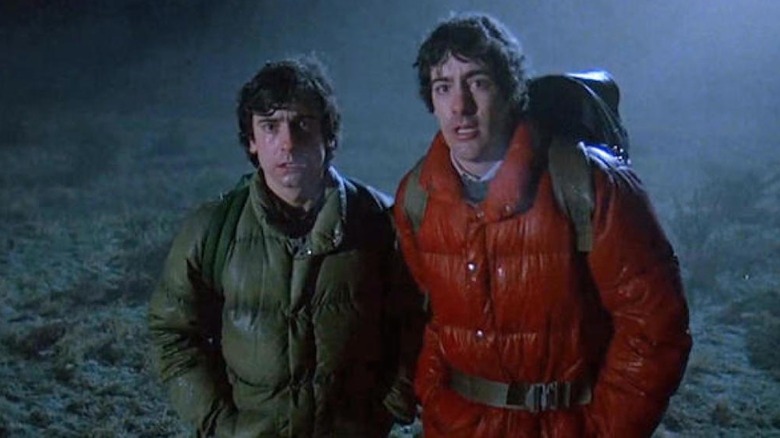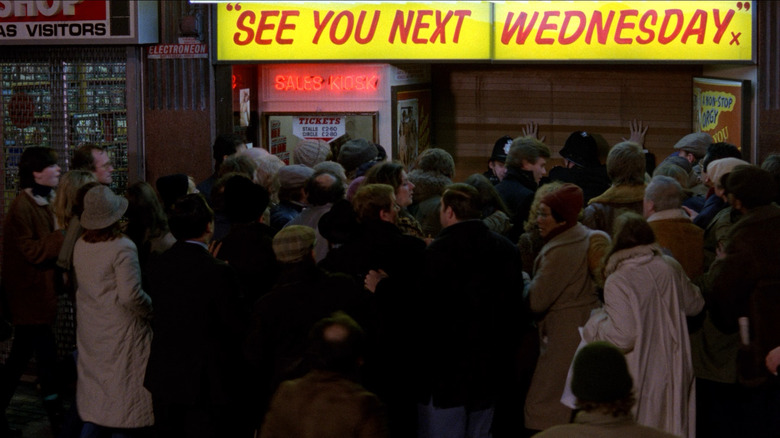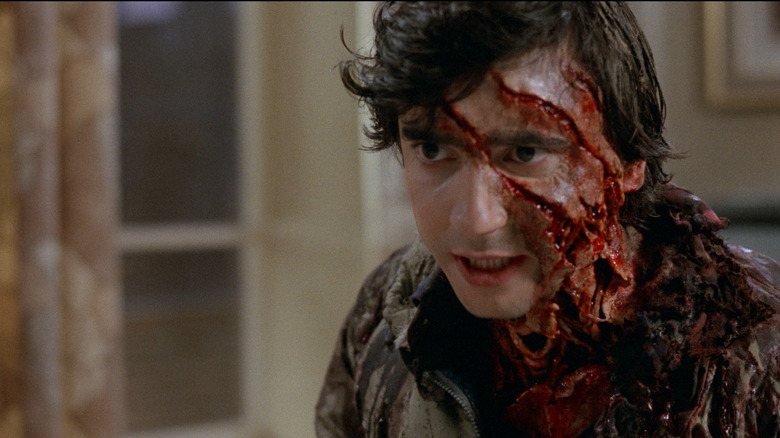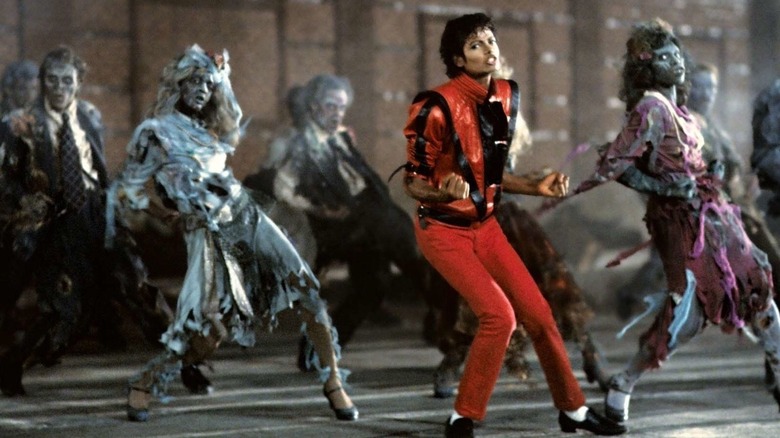The Untold Truth Of An American Werewolf In London
When moviegoers first saw "An American Werewolf in London," many didn't know how to process the bizarre film. Since director John Landis was well-known for making comedies, most people expected a horror spoof, and it came as a shock that the film was actually an attempt at genuine horror — and more surprising still that it succeeded in genuinely frightening the audience.
Without a doubt, the movie has its humorous and lighthearted moments, yet these scenes are brilliantly intertwined with a macabre tragedy that makes you feel sympathy for the lead character even as he becomes a terrifying monster who slaughters innocents without mercy. The film, with its seemingly out of place components, may have been considered odd at first, but it didn't take long for it to be appreciated by the masses as the unique horror masterpiece it really is. This is the untold truth of "An American Werewolf in London."
The script was shelved for a decade
In an interview with IndieWire, director John Landis described how he began working on the screenplay for "An American Werewolf in London" in 1969, when he was still a teenager. While serving as a production assistant during the filming of "Kelly's Heroes" in Yugoslavia, Landis and a coworker were traveling down a road when they witnessed a gypsy funeral. The recently deceased man was wrapped in garlic and buried feet first in an abnormally deep grave with the hope that the precautions would prevent his rising from the dead.
The experience inspired Landis to start writing a horror story, and it didn't take him long to finish the script. Convinced that an encounter with the undead was one of the most terrifying things he could experience, he was intrigued with the idea of how an 18-year-old like himself would deal with such a horrifying situation. However, the idea did not garner much interest at first, so he was forced to stow it away for more than a decade.
Over the course of that decade, Landis made a name for himself with a string of well-received comedies that included "The Kentucky Fried Movie," "Animal House," and "The Blues Brothers." His career established, the director was finally able to make his werewolf film in 1981.
Werewolves are international
Even though the funeral rites that inspired Landis were driven by a fear of zombies, he wanted to go in another direction for his film. As he later recalled, "I knew I didn't want to do a serial killer or a zombie, I wanted something where you really had to suspend disbelief. I settled on werewolves mainly because, other than ghosts, they're the only really international monsters — every culture has man-beast stories. Even Dracula can turn into a wolf!" Historic Mysteries explains that not only have werewolf legends originated around the world, but the beasts are some of the oldest monsters in recorded history.
Landis was also more interested in the complex nature of the werewolf character for the featured monster. "I really took from the Lon Chaney 'Wolfman' picture because what that added was this element of tragedy," he added. "Historically, people in France and Wales were burned to death for being werewolves or witches and the film made it a curse, where the wolfman himself is a victim."
All this history and complexity means werewolves are never too far from the cultural zeitgeist. Although Landis had to wait years before he could get "American Werewolf in London" made, it arrived at a real moment for the beasts — "The Howling," "Wolfen," and "Full Moon High" were all released the same year.
One of the last Eady Levy films
"An American Werewolf in London" was actually filmed in the U.K., but the reasons were more financially than artistically driven. As John Landis explained, "When I was shooting 'Werewolf,' Warren Beatty was shooting 'Reds' here and there was also another little film in progress called 'Raiders of the Lost Ark.' These were all made under a very useful tax-break agreement called the Eady Levy, which began the boom of Americans coming to make big pictures with largely British casts and crews in London in the 1960s. Turns out mine was one of the last Eady pictures made."
Filmmakers often use studio sets and other means of trickery to make audiences think they're seeing a different part of the world, and the effect can be seamless — but there's still nothing like the real thing, so "American Werewolf" fans can thank the Eady Levy for this film's verisimilitude. Still, even with the tax breaks, Landis at one point considered moving the location to Paris and filming in France instead.
Nasty weather was desired
John Landis wanted poor weather throughout the movie, so he scheduled filming for February and March. This was especially difficult for lead actor David Naughton, who had to run around naked outside in the freezing cold. In an interview with The SF Site, the actor recalled, "That's rather difficult to do because it's cold and you've got no shoes on and I don't jog in bare feet in any weather, even back in California. That's the hardest part, you're running in wooded areas, on slick paths, trying not to look like you're going, 'Ooh, ow, oh, ouch!' And they were saying, 'C'mon, it's warm, this is a dream, you're leaping, you're like a deer.' So I just had to go for it."
While the production was set up in the town of Crickadarn in Wales, there was such bizarre weather that at one point it snowed, sleeted, rained, and had periods of clear sunshine all in the same day. Landis always wanted the right look, even if it was very uncomfortable for the actors. As Naughton recalled, "We were in England and it's not raining so they made rain. Why would you make rain in England? We're out there on the moors with these rain machines. It was so cold the rain machines were freezing. 'Hey, wait a second, that's not fair. If the rain machines are freezing, then we shouldn't have to be in the rain, should we?'"
Long hours in the makeup chair
Renowned makeup and special effects expert Rick Baker put in meticulous detail to create the "American Werewolf" visuals that are still admired today. Bloody Disgusting recounts the many months of prep work for the transformation scene when the audience first sees Naughton's painful and frightening metamorphosis into a werewolf. When Baker met David Naughton for the first time, he knew what he was going to put the actor through and said "I feel sorry for you."
To get into his werewolf makeup, Naughton left for work at 4:30am and sat still in a chair for 10 full hours until he was ready for filming, a process he described as "a long flight that never gets there." He complained so incessantly that during a panel, Landis and Baker told him to stop making it sound like he survived torture.
Griffin Dunne's experience was also unpleasant, but not as bad as Naughton's. When talking about Baker and the process, Naughton's co-star recalled, "I hated the makeup. I loved Baker; he made the six hours bearable. The makeup's on, and then it constricts and then it pulls on your skin and then it has to be loosened up; you have people fussing with you; you want to pass out from the fumes. The glue is kind of like airplane glue, so it wasn't comfortable."
Rick Baker won the first Academy Award for makeup
David Naughton may have been vocal about the torturous process he had to endure, but there's no doubt that he respected Rick Baker's impressive techniques. As he put it, "I had worked with the best, or the person who would soon become one of the top makeup artists." And Naughton is obviously far from the only one to appreciate the artist's talent. Not only did Baker win an Oscar for his revolutionary makeup effects, but he was the first to ever earn an award for an entirely new category that was created in 1981, as noted by the Academy of Motion Picture Arts and Sciences.
"American Werewolf in London" continued a partnership that Landis and Baker struck up on the director's first film, 1973's "Schlock," when both men were barely in their 20s. "I want to do this transformation in a way that it hasn't been done," Baker recalled Landis telling him of the pivotal werewolf scene. "I cannot believe if you are going to change into a wolf-man or Mr. Hyde or whatever, you're going to sit in a chair and wait for it, wait for the transformation to take place. Show the pain."
John Landis fought for diversity
It may have been cheaper to film the movie in the UK, but John Landis ran into some serious problems, including a major casting issue. "I had terrible trouble with the unions," he recalled (via The Guardian). "At that time, you couldn't find what they then called a 'colored' face to be an extra." Unwilling to take no for an answer, the director wanted the movie to show London the way it actually looked in real life.
Landis noticed other productions that only hired white actors and extras. "I remember after George Lucas shot 'Star Wars' in London," he recalled. "He showed it to all of us and I said to him after the screening: 'George, is everybody in outer space white?' I knew London to be a multicultural place — we filmed in the year of the Brixton riots, remember — but I just couldn't get Indian or Black faces to be in the crowd." The director stuck to his guns, though, and continued to fight until he was able to hire who he wanted.
The film almost became An American Werewolf in Paris
While Landis was making sure all the necessary steps were taken so that the film could be made in the UK, the government informed him that he needed four work permits — for himself, Rick Baker, David Naughton, and Griffin Dunne — but he soon learned they didn't want to give out more than three. While Naughton, Landis, and Baker easily got the permits, the union initially prevented Dunne from working in the country because it preferred the role to be played by an American actor already living in the UK.
Again, Landis remained firm, threatening to change the location of the story to France and modify the screenplay accordingly. As a sign for how serious he was, Landis even scouted possible places to shoot in the rival country instead, according to Total Film. In the end, Landis' hardball tactics worked, and Dunne was awarded his permit.
France lost this round, but when "An American Werewolf in London" received a belated sequel in 1997, Landis' threats proved inspirational — "An American Werewolf in Paris" moved the story's action across the Channel.
John Landis bribed police to film
The tense climax of "American Werewolf in London" takes place at Piccadilly Circus, which is an often chaotic intersection bustling with traffic. In order to film scenes of the werewolf rampaging through the crowded area, Landis needed to prove to the right people that he could pull it off without shutting the whole place down.
Landis already had success working with the Chicago police for "The Blues Brothers," which seems likely to have been useful when approaching officials in London. After inviting 300 police officers to attend a free screening of "The Blues Brothers," the director was allowed to film at the Piccadilly Circus — the first time that had been allowed in 15 years, according to Dread Central. To help seal the deal, Landis recreated the whole area so the crew could rehearse and get it perfect before filming actually began.
John Landis only wanted Moon songs
For the movie soundtrack, John Landis managed to get the rights to three versions of "Blue Moon," Van Morrison's "Moondance," and Creedence Clearwater Revival's "Bad Moon Rising," all songs with "Moon" in the title. The first rendition of "Blue Moon" used in the film is Bobby Vinton's, followed by Sam Cooke's and then the version performed by the Marcels.
Landis may have succeeded in securing those tracks, but he failed to secure others he wanted very badly. Possibly on the top of that list was "Moon Shadow" by Cat Stevens, who had recently converted to Islam. Not only was Stevens opposed to having his work associated with supernatural themes, but he didn't want any of his songs featured in a movie that was rated R. Similar to Stevens, Bob Dylan refused to give permission to use his version of "Blue Moon," and Elvis Presley's rendition was simply unavailable to anybody.
The crew shot a film within a film
"See You Next Wednesday" is a short adult movie within the film that the "American Werewolf" crew actually made. As John Landis explained, "When I was working [in London] in the 1970s, I went to those little cartoon theaters they had, such as the Eros on Piccadilly. So in the original script, I had him going into the Eros and there was a Road Runner cartoon playing. But when I got back to London in 1980, all these theaters had become pornos. So I had to change the script to show a porno called, in the best smutty British tradition, "See You Next Wednesday." We made the porno ourselves and it was the first scene we shot."
"See You Next Wednesday" is playing at the Piccadilly Circus cinema near the end of "An American Werewolf in London" when the protagonist is confronted by the undead specters of the innocents he slaughtered in his beastly form. According to Little White Lies, the title was a line used as a type of running joke throughout all of Landis' films — and just as the movie it's featured in blends comedy and horror, "See You Next Wednesday" has its share of humor as well.
The unrated cut
John Landis wanted "American Werewolf in London" to be a true horror film that terrified audiences, but he was careful to make sure it was tame enough to secure an R rating, meaning the sex scenes weren't too gratuitous and he had to lose a shot showing a piece of toast falling out of Griffin Dunne's ripped open throat. There were other gory shots and scenes that Landis did film, but ended up removing before the theatrical release.
A much bloodier version of the movie exists, but there are unfortunately few copies of it left today. According to Fast-Rewind.com, the unrated cut is four minutes longer with more shots of the werewolf and extra gore.
A longer scene showing the werewolf brutally killing a group of three homeless men was taken out because there was such a negative reaction from test audiences. Landis got his R rating, but he later admitted that he regretted toning down the horror.
Michael Jackson wanted the Werewolf crew for Thriller
"American Werewolf in London" took some time to acquire its cult status, but it had some major fans right away — including Michael Jackson, who liked John Landis and Rick Baker's work so much that he asked the filmmakers to make the music video for his song "Thriller" in 1983. "He called me up," Landis later recalled. "My only marching orders were, 'I want to turn into a monster.'"
As recounted by the Los Angeles Times (via the Baltimore Sun), Landis and Baker were quickly on board for the project, along with fellow "Werewolf" vets such as producer George Folsey Jr. and Landis' wife, costume designer Deborah Nadoolman Landis. The team also included cinematographer Robert Paynter and composer Elmer Bernstein, making "Thriller" a mini-"American Werewolf" reunion. The pop star was certainly pleased with the results — he had Landis direct another one of his music videos, "Black or White," in 1991.
